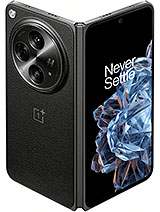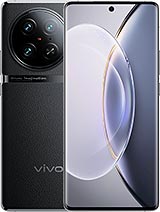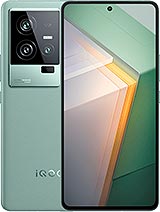iQOO 12 review

Android 14 and Funtouch 14
The iQOO 12 boots Android 14 with a Funtouch OS v14. This is the first phone we met with the new Funtouch version, and we got some promises with that - less bloatware, three years of Android updates, and four years of security patches.

Funtouch v14, while indeed cleaner and more refined, isn't that different in look and feel. And it's a pretty customized and customizable experience.






Lockscreen • Homescreen • Homescreen • Folder view • App drawer • Settings menu
One of the useful proprietary features can be found in the recent apps menu. You can choose between the standard carousel formation and a horizontal tiles layout - sort of like MIUI, only scrollable horizontally. The setting is available right then and there - you don't need to look for it in the menus.




Recent apps • Recent apps • Pop-up • Spilt screen
The notification shade is pretty familiar, now adopting some of Google's large bubble-style quick toggles.
The app drawer has an expandable recommended apps category on the top (most commonly used ones), whereas using the vertical scroller on the right would highlight the apps beginning with the selected letter.




Notification shade • Quick toggles • App drawer • Widgets next to the app drawer
The rest of the UI has plenty of non-stock bits. In the Dynamic effects sub-menu, vivo has grouped a bunch of customization options for the home screen, lock screen and animation effects. There are even various charging and facial recognition animations.
The always-on display settings are in a different sub-menu, but the phone still gives you plenty of options to tinker with - a wide selection of animations, clock styles, colors, backgrounds.
The Sound menu holds a few pleasant surprises. Just like Samsung and its OneUI, Funtouch takes care of people with hearing problems, and you can calibrate the sound to be heard by elderly people or those with impaired hearing. Additionally, notifications and calls get separate volume sliders. The vibration intensity can be adjusted for calls and notifications independently. No system-wide equalizer is available for the loudspeaker, though, which could be either a negative or a positive, depending on how you look at it. An Audio Super Resolution toggle is thrown into the mix.
Holding the volume down key can be used to launch an app or do a certain task, although the list is limited to the camera app, turning on/off the torch, start recording audio, open Facebook, or open any custom app. The so-called Quick action feature doesn't work when playing music for obvious reasons. Why isn't there a double-press option for Quick action, though?






Shortcuts and accessibility • Quick action • Smart action • S-capture • Easy Touch • Smart Sidebar
A dedicated Ultra Game Mode is available, and it has it all. Most of the features are about mitigating disturbance during gameplay or preventing certain apps from displaying notifications. One of the most intriguing features that have been around on vivo phones for a while is the ability to turn off the screen and keep the game running in the background. Especially useful for turn-based games or those requiring some sort of "farming" or "grinding".
The Funtouch launcher also offers its own gallery, audio and video players, system manager, and Smart Remote (for the IR blaster). There is also a dedicated Themes app and the vivo App Store is present.






Albums • Video • Music • Smart Remote • Themes • Vivo App Store
While iQOO has indeed reduced the bloatware, there are still quite a few pre-installed apps like iQOO, iQOO Coud, Shopee, Spotify, TikTok, Viu, Agoda. You can uninstall them, of course, but they are still part of the infamous bloatware.
Performance and benchmarks
The iQOO 12 is the first smartphone with the latest Snapdragon 8 Gen 3 chipset to pass through our office, and it is supposed to be 30% faster and 20% more efficient compared to the Snapdragon 8 Gen 2. It is built on the 4nm process and has a clear focus on AI, gaming, audio, and camera advancements.

The eight-core processor inside is highlighted by 1x Cortex-X4 prime core running up to 3.3 GHz, 5x performance Cortex-A720 based cores at up to 3.2 GHz, and 2x efficiency Cortex-A520 based cores clocked up to 2.3 GHz. It is a four-cluster processor with 1+3+2+2 structure.
The Snapdragon 8 Gen 3 and its new Adreno 750 GPU can deliver 'console-defying' gaming with 240 fps support on 240 Hz displays. Adreno Frame Motion Engine 2.0 can generate frames for smoother playback, and there's Unreal Engine 5.2 support. The GPU is 25% faster, 25% more power efficient, and brings 40% better Ray Tracing compared to the Adreno 740 inside the SD8G2.
AI is front and center in the Snapdragon 8 Gen 3. It all starts with the AI Engine, which supports multi-modal generative AI models and popular large language models for speech recognition - the chip can run up to 20 tokens per second for instant AI assistant responses. Qualcomm boasts that the Snapdragon 8 Gen 3 packs the world's fastest stable diffusion, which can generate an image in a fraction of a second. AI enhances the camera's abilities as well. For example - Semantic Segmentation can enhance the vibrancy and detail of images in real-time, while Night Vision video can brighten a dark scene.
There's LPDDR5x memory support up to 4800 MHz and as much as 24 GB. The chip supports Wi-Fi 7 up to 6 GHz, including 802.11be, 802.11ax, 80211ac, and 80211a/bg/n. The chip features the X75 5G modem with both sub-6 GHz and mmWave antennas.
The iQOO 12 is available in three configurations of LPDDR5x RAM and UFS 4.0 storage - 12GB/256GB, 16GB/512GB (ours) and 16GB/1TB.
And, it is benchmark time!
We start with the CPU-intensive Geekbench test. As per Qualcomm, the Snapdragon 8 Gen 3 should be 30% faster than the Snapdragon 8 Gen 2. The jump in performance that we observed was a healthy 30% for multi-core and 20% for single-core operations.
Next, GPU tests. Here, Qualcomm claims the new Adreno 750 GPU is 25% faster than the Adreno 740 inside the SD 8 Gen 2. Plus, it is also more power-efficient and should offer 40% better raytracing.
In our offscreen testing, the new GPU was around 20% better than the old one, indeed.
We also got around 20% improvement compared to the non-overclocked SD 8 Gen 2 in the 1440p 3D Mark Wild Life Extreme test, which runs offscreen again.
In the 3D Mark Solar Bay test, which is a ray tracing benchmark, we saw a whopping 45% improvement in performance from our Snapdragon 8 Gen 3 device.
Finally, who doesn't love a good AnTuTu comparison chart? This compound benchmark takes into account many aspects of the devices, including storage, RAM, display resolution, etc, so it's not a great tool for comparing platforms. It's much better to compare specific devices.
In this test, the iQOO 12 and its Snapdragon 8 Gen 3, occupied the #1 spot in our all-time review chart. Nice!
So overall, it's a great showing from Snapdragon 8 Gen 3. We are looking at up to 22% net performance improvement in CPU and GPU performance compared to the best Snapdragon 8 Gen 2 devices we've ever tested.

And it's worth noting the IQOO 12 didn't get excessively hot during benchmarking, just warm, which is another promising thing for the new chipset.
We did test the stability of the chipset, of course, and it turned out quite good. The CPU stress tests revealed a stability score of 74%, which is excellent for a top-of-the-line SoC with a passive cooling solution.
The GPU stability turned out to be around 55%, which is not great, not terrible. We expected a bit more, to be honest, but seeing that many phones do 40% or less, we'd gladly take this win.
Overall, we are very happy with the SD8G3 performance on the iQOO 12. The phone appears well-geared for gaming; it supports high frame rate in games, and not only does it feature the most powerful Android chip right now, but it also cools it adequately.
Reader comments
- Abhay
- 21 Mar 2025
- rK8
Hey, I am confused between iqoo 12 and oneplus 13r, which is better overall? Which has better camera? Please help.
- Anonymous
- 03 Mar 2025
- 7k3
Try to get the latest one if possible since the price is comparatively same
- Zen Moon
- 28 Nov 2024
- tsP
Incorrect. My iqoo12 always fully charges the battery for 35 minutes



































